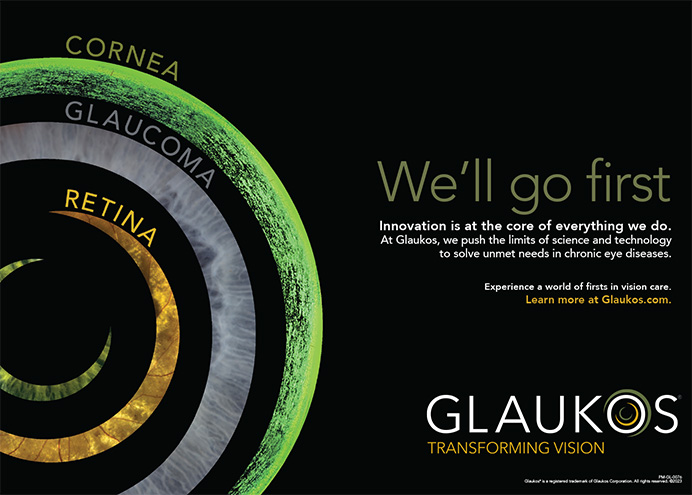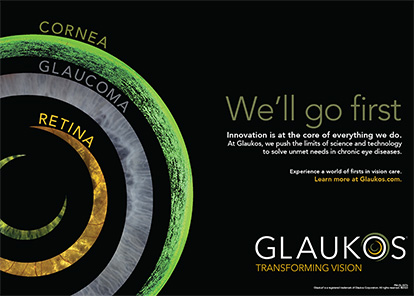Microinvasive glaucoma surgery (MIGS) uses a new class of surgical devices for glaucoma management defined by ab interno implantation. The iStent Trabecular Micro-Bypass (Glaukos Corporation), the first MIGS glaucoma implant to be approved in the United States, is indicated for use in conjunction with cataract surgery for the reduction of IOP in adult patients with mild to moderate open-angle glaucoma currently treated with ocular hypotensive medication.
The safety and predictability of the iStent has opened up a new class of surgical management for glaucoma patients.1 Traditional glaucoma surgeries such as trabeculectomy and the implantation of tube shunts have an unacceptable rate of complications to be considered routinely for patients with mild and even moderate glaucoma. With the approval of the iStent, which essentially exposes the patient to no more risk than the cataract procedure alone,1 cataract surgeons can consider surgically managing even the mildest cases of glaucoma.
A MORE EFFECTIVE TREATMENT OPTION IS NEEDED
In the United States, there are over 3 million cataract procedures performed each year, and more than 650,000 cataract patients have the comorbidity of glaucoma or ocular hypertension.2 Although cataract surgery can lower many glaucoma patients' IOP, the majority will continue to require medical therapy after the procedure. 3 Numerous studies have documented patients' poor compliance with long-term medical therapy such as eye drops for glaucoma.3 In addition, diurnal fluctuations in IOP may stealthily compromise the vision of patients whose IOP seems to be well controlled by medical therapy. Finally, cataract and refractive surgeons understand the quality-of-life issues associated with the long-term use of topical medications. They also understand the benefits of a cost-effective, microinvasive, safe glaucoma procedure that could be performed at the time of cataract surgery. A procedure that offers patients improved IOP control and either a reduction in or elimination of glaucoma medications would be exciting.
CHANGING THE TREATMENT PARADIGM
The treatment paradigm for glaucoma management is evolving rapidly. New alternatives have become available that enhance patients' quality of life and compliance with glaucoma therapy. As a result, clinicians' views are changing on what is an acceptable glaucoma intervention, and they are better able to meet their patients' demands. I am excited to use the iStent routinely on all of my patients undergoing cataract surgery who have mild and moderate glaucoma.
Traditional Approach
Traditionally, patients are placed on three to four medications for IOP control before surgery is considered. Until now, patients have had to endure damage to the ocular surface, expense, and dosing and compliance difficulties. Expense and compliance are major, interrelated issues. Many patients are responsible for copayments of $20 to $50 per glaucoma medication each month. Although prostaglandin analogues are dosed once daily and are a first-line treatment, some medications have to be administered several times a day to maintain optimal IOP control. Missing just one dose can cause a spike in the IOP which can lead to optic nerve damage and a worsening of the disease. Additionally, topical glaucoma medications can have significant local and systemic side effects that range in severity from mild dry eye disease to cardiac arrhythmias.
Novel Approach
Rather than a last resort, I will now consider MIGS as a first-line option for patients with mild or moderate glaucoma. I will, however, continue to refer patients with significant visual field loss and uncontrolled IOP to my glaucoma colleagues for a trabeculectomy or implantation of a tube shunt.
The iStent reliably reduces IOP.4 The FDA has approved the implantation of one iStent at the time of cataract surgery, but studies conducted internationally suggest that adding a second iStent increases the efficacy of the procedure with no additional risk to the patient.5 Based on my experience with implanting this device, my current nomogram is quite simple. I plan on using one implant for patients on one topical medication and two for patients on two or more medications. Additionally, although the device is approved for implantation during cataract surgery, I believe it could be implanted as a standalone procedure. I have had excellent experience inserting the iStent in phakic eyes while evaluating the technology in Armenia.
SURGICAL TECHNIQUE
The surgical technique is straightforward, and the learning curve involves a few cases. I began by practicing gonioscopy in the office and then transitioned to performing intraoperative gonioscopy to familiarize myself with the angle's anatomy. The microscope should be tilted toward the surgeon, and the patient should be tilted away from the surgeon (Figure 1). After cataract surgery, I fill the angle with viscoelastic and insert the preloaded iStent into the eye through the temporal cataract incision. The devices are clearly labeled for the left and right eyes. I enter the anterior trabecular meshwork (TM) at a small angle and gently insert the device through the TM. Next, I release the implant and tap it into position with the inserter (Figure 2).
A small amount of blood will come back through the lumen of the stent, which is normal and signals that the device is properly positioned. If necessary, I insert additional viscoelastic to clear the blood and evaluate the device's position. The stent is implanted ab interno, thus preserving the conjunctival tissue and avoiding the serious complications associated with end-stage filtering procedures. The procedure has minimal to no risk of hypotony due to the physiologic preservation of the TM.1
REIMBURSEMENT
With the creation and introduction of a new market class, surgeons will confront initial challenges in securing appropriate reimbursement for this novel procedure and technology. Fortunately, Glaukos laid the groundwork for reimbursement during the commercial launch phase. The company successfully petitioned the American Medical Association and has secured two category 3 Current Procedural Terminology codes (0191T for the reimbursement of the trabecular bypass devices and 0253T for the reimbursement of suprachoroidal devices), which will allow Medicare contractors and other third-party payers to assign physician payment levels for these new procedures. The Centers for Medicare & Medicaid Services has assigned these Current Procedural Terminology codes to ambulatory payment classification 673, which will reportedly provide adequate payment to the facility for the cost of the procedure and the device. The company has also created a program to help surgeons with appeals in the event of initially denied claims.
A NEW GOAL
Moving forward, I predict a paradigm shift in ophthalmology, cataract surgery, and glaucoma management. Although glaucoma medications will still be necessary, the iStent will move surgery to the forefront as a cost-effective treatment. As doctors and patients seek better IOP control and improved quality of life for their patients, medication will shift into a secondary position for controlling glaucoma. The device changes the surgical management of glaucoma and opens a window of opportunity for cataract surgeons to safely and effectively manage glaucoma at the time of cataract surgery. The ability to treat the cataract, achieve emmetropia, and reduce or eliminate patients' need for glaucoma medication is the new goal for the comprehensive refractive cataract surgeon.
Eric D. Donnenfeld, MD, is a professor of ophthalmology at NYU and a trustee of Dartmouth Medical School in Hanover, New Hampshire. He is a consultant to Abbott Medical Optics Inc., Alcon Laboratories, Inc., and Glaukos Corporation. Dr. Donnenfeld may be reached at (516) 766-2519; eddoph@aol.com.
- Samuelson TW, Katz LJ, Wells JM, et al; US iStent Study Group. Randomized evaluation of the trabecular micro-bypass stent with phacoemulsification in patients with glaucoma and cataract. Ophthalmology. 2011;118(3):459-667.
- Centers for Medicare and Medicaid Services. 2002-2007 Medicare Standard Analytical File. Baltimore, MD: Centers for Medicare and Medicaid Services, US Department of Health and Human Services; 2007.
- Okeke CO, Quigley HA, Jampel HD, et al. Adherence with topical glaucoma medication monitored electronically: the Travatan Dosing Aid Study. Ophthalmology. 2009;116(2):191-199.
- Poley BJ, Lindstrom RL, Samuelson TW, et al. Intraocular pressure reduction after phacoemulsification with intraocular lens implantation in glaucomatous and nonglaucomatous eyes. J Cataract Refract Surg. 2009;35:1946-1955.
- Belovay GW, Ahmed II. Using multiple trabecular micro-bypass stents in cataract patients to treat primary open-angle glaucoma. Presented at: The ASCRS Symposium on Cataract, IOL, and Refractive Surgery; April 9-14,2010; Boston, MA.


